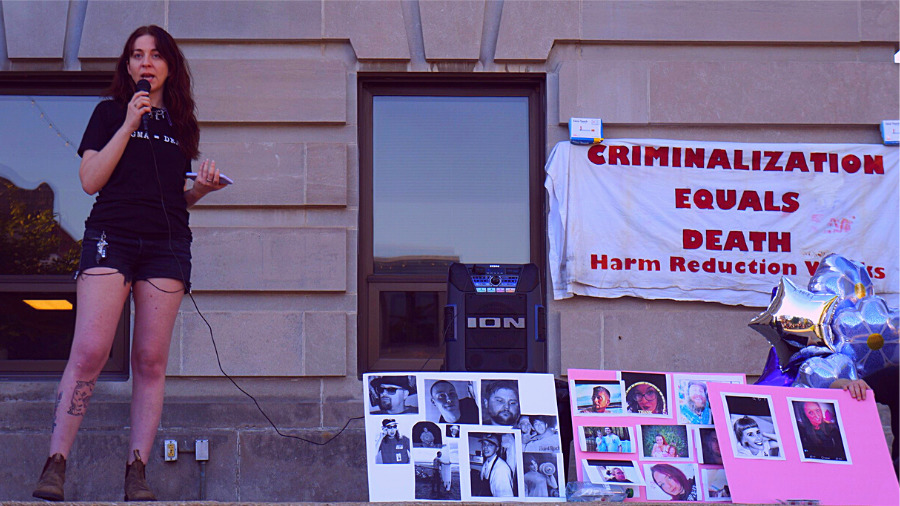The Hancock County Prosecutor, Brent Eaton, recently announced a program to arrest and prosecute overdose victims on the charge of criminal possession. Eaton wrote in a press release that the purpose of this change in policy is designed as a means of forcibly connecting users with abstinence-only recovery programs in the area under threat of punitive and/or carceral action. Citing an anecdotal success story, Eaton has entrusted his officers to fill roles better suited for social workers and counselors, rather than police and jail wardens.
Encouraging police officers to use the possession of naloxone, also known as Narcan, as “probable cause” to obtain evidence for search warrants, this new initiative will lead to more drug arrests and the imprisonment of people, especially poor and working-class people, under the guise of rehabilitation.
The search warrants will include an “Overdose Report” form “to help officers evaluate whether ‘the use of Narcan [was] effective in helping the overdose victim regain consciousness or coherency.’” Greenfield police have significantly increased their drug arrest efforts, and “between 2015 and 2016, drug possession charges leapt from 380 to 612.” The new overdose reports could increase superfluous arrests further.
To get deeper insights into the initiative, ANSWER Indiana spoke with the President of the Board of the Bloomington-based Indiana Recovery Alliance (IRA), Alicia Suarez. Those leading this charge, as Suarez put it, “will have blood on their hands,” by which she means they
“are going to be responsible for fatal overdoses, and we are livid. From everything I’ve seen, they are buckling down on the criminalizing approach couched in compassion. They are reliant on an abstinence-only model which is ineffective and unscientific. Medication-assisted therapy (MAT) is the gold standard for medical professionals. That’s what we need access to for people who want to stop taking opioids, but it’s often cost-prohibitive and limited geographically in distribution. Some drug courts do not allow MAT and will kick out people in recovery who start using again. It’s a process, and as harm reduction specialists we are looking for any positive change.”
Oftentimes, opponents of harm reduction and advocates for mass incarceration rely on scant anecdotal evidence rather than systemic evidence. There’s a good reason for this, according to Suarez. “We have over 30 years of empirical data of the efficacy of harm reduction, showing that harm reduction is the appropriate response to substance use disorder,” she said, before noting the unfortunate reality that
“many LEO simply refuse to acknowledge the proof, and we’re frequently called “enablers”. It’s so clear when you look at the “War on Drugs,” it has been a dismal failure since the 1980s. So the fact that a prosecutor says that the “role of law enforcement is helpful toward recovery” not only shows their purposeful ignorance to decades of evidence to the contrary, as well as their dedication to a highly specific, reactionary ideology that dehumanizes users and does not offer long-term solutions to the public health crises surrounding drug use disorder. Mandating treatment or detox is not effective; the individual has to be at the point where they want positive change and positive change must be identified by that individual. I think what’s happening in Hancock County is a direct response by the state to undo the progress made by harm reduction specialists.”
In April 2018, US Surgeon General Jerome M. Adams issued a statement encouraging all able persons to carry and to know how to administer the overdose-reversal drug, Naloxone: “It is time to make sure more people have access to this life-saving medication… to manage opioid addiction and prevent future overdoses, increased naloxone availability must occur in conjunction with expanded access to evidence-based treatment for opioid use disorder.”
Kassandra Botts, Executive Director of the Indiana Recovery Alliance (IRA), told Filter that “people already do not call for help out of fear of arrest” in a state with weak Good Samaritan laws and where a drug-induced homicide bill was introduced to the state assembly in 2018.” Botts compared the futility of Hancock County’s use of harm reduction practices as a weapon against naxolone users to sex workers who did not use condoms for fear of arrest.
However, the greatest weapon in the hands of those who seek to hinder harm reduction programs is a fearful and misinformed public. It is easy for someone to assume that because possession of syringes is a felony, they should not possess naloxone. A person may fear legal repercussions from the state if they were deemed guilty by association.
Clearly, Eaton is unconcerned about drug users’ actual welfare, using the increase in arrests to fill space at the county’s new jail and justify its construction. Flying in the face of all evidence, he and Greenfield’s sheriff feel that they can provide better treatment than medical professionals. As quoted in the Greenfield Reporter, Sheriff Burkhart feels that the new jail, “which will have a recovery pod unit, where addicts will get better treatment, may be their only hope.”
This misguided policy will lead only to more deaths, not recovery, of those with substance abuse issues.
Photo: Kass Botts, former Executive Director of the IRA, speaking at an overdose vigil. Credit: IRA.

